One mistake you don’t want to make is underfeeding or overfeeding your guinea pig as this could be detrimental to their health – and I’m sure you don’t want to hurt your little pet.
But, how often do you feed guinea pigs? I made a research on this, coupled with my own experience – and I found that guinea pigs feed on a consistent schedule, 2x per day, morning and evening.
But, in this article, we’ll be going more in-depth into guinea pigs feeding habits so you can better understand how often to feed your guinea pigs.
How Often Do You Feed Guinea Pigs?
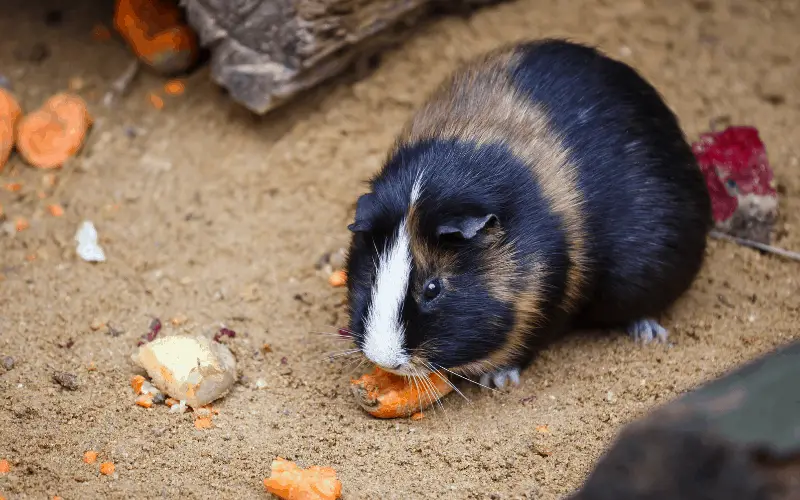
Basically, how often you feed your guinea pig matters a lot because the guinea pig will need both fresh and dry food every day. So, you have to feed them always because they do not care about which time of the day it is or which time of the year it is, they just eat.
I do advise all my readers that they should always treat their pet animals, regardless of which animal they are, just like we treat our babies.
Just like newborn babies, you don’t have an idea when they will start crying for food, you have to be always prepared to feed them when they start crying for it.
But sadly, you can’t be that prepared to feed your guinea pig when they start crying for food that is why it is better to leave them with abundant food so they can eat whenever they can as well as an unlimited supply of hay.
Precisely the kind of fresh food you choose to feed your guinea pig more often will determine how much food they’ll need, but an excellent guideline to follow is roughly one cup of vegetables per pet per day.
Fruit should always be given to them more often, as it’s very acidic and can cause sores around your guinea pig’s mouth. Some guinea pig owners advise keeping the dry food bowl always full so that your pets can graze throughout the day.
Still, others recommend about one-quarter to one-third of a cup per guinea for a day, with perhaps slightly more if it’s a bit cold outside, they’ve been ill, they are young, or if they have been pregnant or suckling recently.
If you start observing that your guinea pigs are getting a little on the chubby side, then you might have to reduce the amount of dry food you’re giving them more often.
Try reducing it to one-quarter of a cup per guinea per day at first for a few months, and then if the problem persists, try reducing it a little bit more.
Guinea pigs don’t usually overeat but will definitely do so if given a chance and this might lead to obesity, so, to prevent obesity, remove pelleted food that is left uneaten after 24 hours.
Never add new food, including hay, before cleaning out the old food, but it’s crucial to provide the proper balance of pellets, hay, and fresh vegetables.
Continue making available unlimited food and vegetables as usual during this period of dieting, and obviously, stop offering treats.
What Do Guinea Pigs Feed On More Often?
Guinea pigs are plant eaters/natural herbivores and would spend their time foraging and grazing in small herds in the wild. They need to be provided with the types of food they have adapted to eat more often.
Their teeth are constantly growing, which is one of the reasons why they need plenty of roughage to chew; this wears down their teeth and helps prevent serious dental problems.
Providing sufficient fiber in their diet is also very important for both their gastrointestinal system and general health, they can eat quite a wide variety of foodstuffs.
But be a little careful as they often don’t know what’s right for them. Many a pet has had an agitated stomach (or worse!) after eating something they shouldn’t.
What To Always Feed Your Guinea Pig
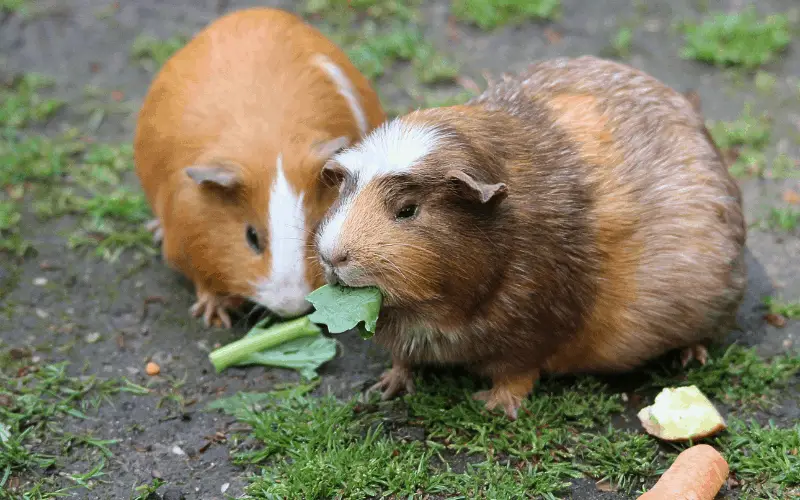
1. Grass
Lush green grass is a recommended or best food for guinea pigs the world over. If you are the type that keeps your guinea pigs indoors, pushing a handful of this into their hutch will produce the most exciting sounds you’ll ever hear.
A nice handful of lush, thick grass is an excellent addition to your guinea pigs’ diet, but be sure to check it for dangerous plants, and not to give them mowings.
Mowings can contain fungus and well-disguised poisonous plants, as well as having the capacity to cause the potentially fatal condition known as bloat.
It’s essential to be careful when giving your guinea pigs grass, as lots of very common plants are poisonous to them.
Buttercups and daisies are usually problematic, so have a good look around if you’re seizing some grass for your guinea pigs to munch on, or if you’re seeking a spot to put their outside run on.
Check out our post on “what guinea pigs shouldn’t eat” for more information.
2. Water
This should always be made available to your guinea pigs as it is a basic necessity, in their special bottle.
It’s commendable to use a proper guinea pig water bottle rather than a loose bowl, for reasons both of hygiene and clumsiness – if you try to give your guinea pigs a water bowl, they’ll either sit in it or tip it over and get it all over their lovely dry house.
Their water can will need to be cleaned often, as food from their cheeks often goes back up the spout and mills around in the water. You’ll need to clean it out and scrub it regularly.
3. Hay
Hay is amazingly vital for guinea pigs, and they should never be without it. Not only is it a comfortable place to lay on, but they eat a lot of it every day to give their stomachs some roughage for digestion.
4. Fresh fruits and vegetables
These are essential to any guinea pig diet. You’ll need to provide them with plenty of fresh vegetables so that they can get all the nutrients they need, like the all-important vitamin C.
Salad vegetables should be given in a calculated way, as these are mostly water and don’t contain enough energy and nutrients to be a staple of your pets’ diet. Any individual guinea pig will need about a cup of fresh vegetables a day, with the occasional piece of fruit on the side.
Give them fruits sparingly, as it’s quite acidic, and too much can cause sores to form around your guinea pig’s mouth. To be enlightened more, have a look at our recommended ‘guinea pig fruits/vegetables list’.
- Carrots
- Sweetcorn (the leaves can be given, too)
- Broccoli
- Cabbage
- Lettuce
- Peapods
- Beetroots (skinned)
- Cucumber
- Celery
- Apples
- Pears
- Tomatoes
5. Dry food
There are lots of options for your guinea pigs that are available in any good pet shop. If you’re concerned that your pigs aren’t getting enough vitamin C, then there are dry food options that have some supplements.
But this has a short shelf life, so it’s not a second option for lots of fresh veggies. You’ll need to provide your guinea pigs with fresh dry food every day, and you’ll likely need to clean out their bowl once a week – otherwise, it can get a bit mashed, wet and dirty.
How to Create Healthy Feeding Habits For Your Guinea Pig
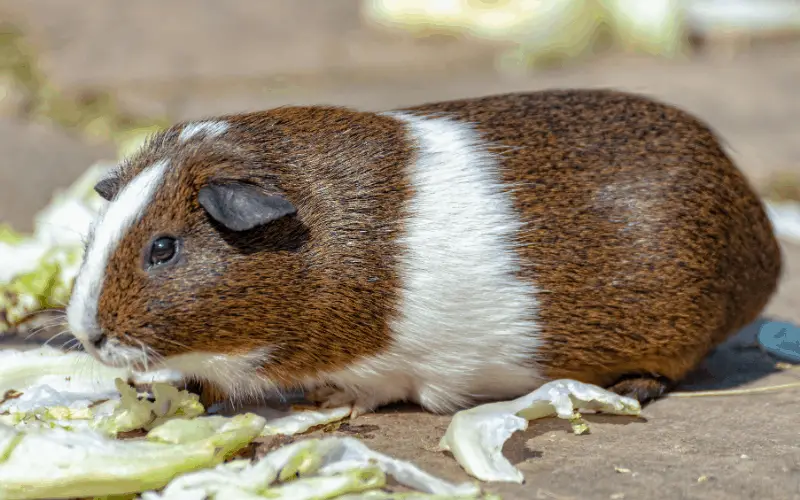
Make sure that your guinea pigs have a steady supply of grass and hay more often (such as Timothy, Oaten, Barley, or grassy hay).
They should not be fed Lucerne (alfalfa) or Clover hay, as they contain a high protein and calcium.
The hay that you feed your guinea pigs should be available the whole day and of good quality; dry, sweet-smelling, and not contain any mold, mildew, or fungus. This is essential in providing a full diet and encourages guinea pigs to chew for long periods.
This chewing helps to slow down their continuously growing teeth and is very important in maintaining dental and gastrointestinal health.
The hay should carefully be contained in a basket or hayrack to prevent it from sitting on the enclosure floor and getting contaminated by your guinea pigs’ waste and becoming a bit wet, moldy, and dirty; this is not hygienic and could make your guinea pigs sick.
Give them a variety of fresh leafy green vegetables & herbs more often. Some basic suggestions that can be used include dark leafed lettuce varieties such as rocket, dandelion greens, snow peas, and herbs such as marjoram, borage, marigold, nasturtium, rosemary, parsley, coriander, basil, and dill.
Other foods that are recommended to feed guinea pigs a few times a week include broccoli, cabbage, endive, carrot tops, Brussels sprouts, kale, silverbeet, mint, and fruits such as apples (but with no seeds), mango, and papaya.
Make a provision for your guinea pigs with a dietary source of Vitamin C because (like humans), guinea pigs cannot produce synthesis Vitamin C from other food substances.
Foods rich in vitamin c such as leafy green veggies and capsicums (green, orange, and red) should be fed to your guinea pigs daily.
Some foods like berries, pineapple, carrots, and kiwifruit are also great as a source of Vitamin C and a tasty treat for your guinea pigs but only feed them some days in a week, not every day, as these foods have quite a high sugar content.
Make sure that you go in search of grass, herbs, fruits, and vegetables that have not been sprayed by any chemicals, as these could harm your guinea pigs.
Things like lawnmower clippings should never be fed to your guinea pigs as these can cause some ailments such as gastrointestinal blockages and make your guinea pigs very sick.
Commercial ‘Guinea Pig’ pellets that are of high quality (minimum 16% fiber content) may be offered in small quantities, but these should not form the central part of the diet.
Although so many of them contain adequate levels of Vitamin C when fresh, this is only when the food is very new, and within just a few months, these foods no longer have Vitamin C.
Leftover food should be removed from your guinea pig’s enclosure after a few hours to ensure that these don’t rot or become moldy and harm your guinea pig.
Always remember that any new foods should be introduced to your guinea pig gradually to allow their digestive system to adjust, so they don’t get sick.
Newly introduced food should be mixed into the existing diet in small quantities, slowly increasing the amount over two weeks.
It is also very essential to know what not to feed guinea pigs, as there are plenty of items that might seem harmless but can cause significant health issues.
Always be careful not to provide your guinea pigs with the following food:
- Cereals
- Grains
- Nuts
- Seeds
- Dried beans
- corn, and peas; buttercups; garden shrubs (like hemlock or privet).
Other are:
- Lilies of any kind
- Sweet peas
- Nightshade
- Oak
- Avocado
- Onion grass
- Onions
- Potato tops
- Mushrooms
- Daffodils
- Foxglove
- Rhubarb leaves
- Human foods like bread, biscuits, sweets, sugar, breakfast cereals, dairy products, chocolate, pasta, crackers, or pickled foods.
If, however, you need to change your guinea pig’s diet, please make sure you don’t rush them, introduce any changes gradually over a few weeks.
Provide clean, fresh water at all times. So many water dispensers should be provided, and enclosures should be fitted with a watering can, and a small water bowl should be available as well.
Making provisions for the opportunity for your guinea pig to graze on grass is also crucial to their wellbeing.
If there is no provision of areas where they can graze safely (for example, free-roaming in a safe enclosure), then offering cut grass is another alternative (however, guinea pigs should not be fed lawn trimmings, as these can cause ailments such as digestive upsets).
When you cut grass to feed the guinea pigs, you need to make sure it is safe. Be sure that the grass has not been introduced with any herbicides or pesticides.
Don’t harvest hay from the roadside as it may be contaminated with exhaust fume toxins or from areas where it might have been soiled by other animals (such as dogs or livestock). The grass should be fresh and green and not have any mold, mildew, or fungus on it.
Just like the case of hay, lucerne (alfalfa) should not be given fresh and clover should be avoided where possible and not given in large quantities).
It is essential that guinea pigs are exposed to a variety of different and healthy foods from a young age, as they may not try or accept new foods later in life.
Note that it is not bad for guinea pigs to eat their soft, nitrogen-rich feces that are derived from their caecum after they pass them. This does not suggest any kind of dietary deficiency or abnormality, and guinea pigs should be allowed to do this.
Conclusion
So many owners of guinea pigs make the mistake of not having a proper feeding mode for their guinea pigs, thereby underfeeding them by not knowing how often to feed their guinea pigs.
Guinea pigs tend not to overeat, but that can only be possible from the way the owner handles them if given the opportunity they will overeat.
I believe that this article has answered the question of how often to feed your guinea pig in a proper way.
Small Pet Select 2nd Cutting Perfect Blend Timothy Hay Pet Food
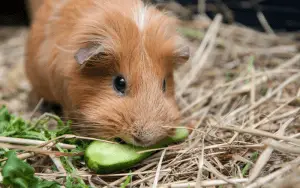
Timothy Hay is the most popular hay for small animals and it's easy to see why. It's leafy hay, with a soft stem, and it has just enough flower heads to attract bunnies (because it's yummy). 80% of your friend's diet should be great hay.
Product SKU: B07CJ2FRNC
Product Brand: Small Pet Select 2nd Cutting Perfect Blend
4.4
Pros
- Good value for the price
- Fresh, green and fragrantly rich scent
Cons
- Inconsistent that some have poor quality hay
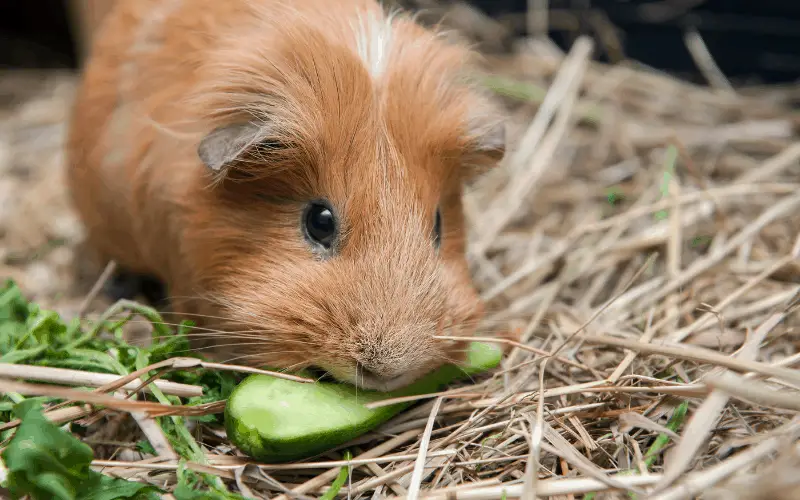
1 thought on “How Often Do You Feed Guinea Pigs?”